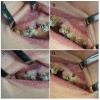Effect of 808 nm Semiconductor Laser on the Stability of Orthodontic Micro-Implants: A Split-Mouth Study
- PMID: 32423127
- PMCID: PMC7287787
- DOI: 10.3390/ma13102265
Effect of 808 nm Semiconductor Laser on the Stability of Orthodontic Micro-Implants: A Split-Mouth Study
Abstract
Background: To evaluate the effect of photobiomodulation (PBM) on orthodontic micro-implants (n = 44; 14 women, 8 men).
Methods: PBM with 808 nm diode laser was applied immediately, 3, 6, 9, 12, 15, and 30 days post the implantation. Results were assessed within same time frames and additionally after 60 days to check for implants stability using the Periotest device. Patients pain experiences following the first day post-treatment and potential loss of micro-implants after 60 days were recorded. The procedure involved insertion of mini-implants in the maxilla for the laser group (L, n = 22) and negative control group (C, n = 22). Irradiation was carried buccally and palatally with respect to the maxillary ridge (2 points). The energy per point was 4 J (8 J/cm2), total dose was 56 J.
Results: Patients did not report significant differences in terms of pain experiences comparing the L and C groups (p = 0.499). At 30 days post-treatment, higher secondary stability of implants was observed in the laser group (Periotest Test Value, PTV 6.32 ± 3.62), in contrast to the controls (PTV 11.34 ± 5.76) (p = 0.004). At 60 days post-treatment, significantly higher stability was recorded in the laser group (PTV 6.55 ± 4.66) compared with the controls, PTV (10.95 ± 4.77) (p = 0.009). Conclusions: Application of the 808 nm diode laser increased secondary micro-implant stability.
Keywords: PBM; PTV; laser biostimulation; low level laser therapy; mini-implant therapy.
Conflict of interest statement
The authors declare no conflict of interest.
Figures




References
-
- Mattos C.T., Ruellas A.C.O., Elias C.N. Is it possible to re-use mini-implants for orthodontic anchorage? Results of an In Vitro study. Mater. Res. 2010;13:521–525. doi: 10.1590/S1516-14392010000400015. - DOI
-
- Costa A., Raffainl M., Melsen B. Miniscrews as orthodontic anchorage: A preliminary report. Int. J. Adult Orthodon. Orthognath. Surg. 1998;13:201–209. - PubMed
-
- Matys J., Świder K., Flieger R. Is it possible to re-use mini-implants for orthodontic anchorage? Results of an In Vitro study. Dent. Med. Probl. 2017;54:101–106. doi: 10.17219/dmp/66363. - DOI
LinkOut - more resources
Full Text Sources

